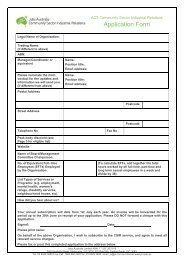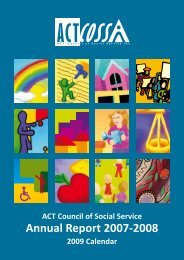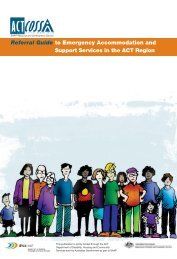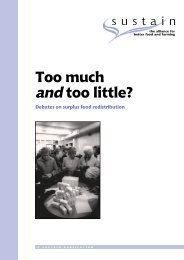actcoss text final.indd - ACT Council of Social Service
actcoss text final.indd - ACT Council of Social Service
actcoss text final.indd - ACT Council of Social Service
You also want an ePaper? Increase the reach of your titles
YUMPU automatically turns print PDFs into web optimized ePapers that Google loves.
development, however does not address the<br />
systemic divide between mental health and disability<br />
sub-sectors and the resulting failures <strong>of</strong> service<br />
coordination. For example, consultation participants<br />
reported that intellectual disability services will <strong>of</strong>ten<br />
not provide services to people with psychosis, and<br />
vice versa. Some community sector services expressed<br />
concern that they did not have the resources to<br />
deal with dual-disability clients even though these<br />
clients were sometimes referred to their service. This<br />
suggests the need for the two sub-sectors to better<br />
coordinate services, and to develop coordinated dualdisability<br />
services. A necessary part <strong>of</strong> this process<br />
is the development <strong>of</strong> dual-disability guidelines<br />
and referral pathways for both mental health and<br />
disability services, to inform their approach to dealing<br />
with dual-disability clients.<br />
RECOMMENDATIONS: IMPROVING THE<br />
RELATIONSHIP BETWEEN THE COMMUNITY<br />
MENTAL HEALTH SECTOR AND OTHER PARTS OF<br />
THE COMMUNITY SOCIAL SERVICE SECTOR<br />
6. Engage in the mapping <strong>of</strong> community<br />
sector service delivery to those<br />
affected by mental illness, identifying<br />
service gaps and needs 91<br />
A service system map should be devised,<br />
including government and community sector<br />
services, to identify gaps in service delivery,<br />
service pressure points (e.g. long waiting lists),<br />
segregated sub-sectors (i.e. with few or poor<br />
linkages), priority new services and priority<br />
innovation areas. We note that the <strong>ACT</strong><br />
Mental Health Promotion, Prevention and Early<br />
Intervention (PPEI) Project, which commenced in<br />
2003, engaged in a mapping process <strong>of</strong> all PPEI<br />
activity in the <strong>ACT</strong>. 92 In this recommendation,<br />
we propose that this initiative be extended to<br />
address whole-<strong>of</strong>-service system service gaps<br />
and network failures.<br />
7. Fund and facilitate a permanent <strong>ACT</strong><br />
cross-sectoral mental health planning<br />
network, involving community sector<br />
service managers, front-line workers<br />
and mental health consumers<br />
The <strong>ACT</strong> Action Plan for Mental Health<br />
Promotion, Prevention and Early Intervention<br />
2006-2008 includes a proposal for Government<br />
and community agencies to:<br />
‘provide forums for continuing development<br />
<strong>of</strong> mental health promotion, prevention and<br />
early intervention in the <strong>ACT</strong> through regular<br />
discussion between sectors connected to mental<br />
health and the broader community, and regular<br />
review <strong>of</strong> progress in implementing the<br />
PPEI Plan.’<br />
In addition, the COAG National Action Plan on<br />
Mental Health 2006-2011 recognised the need<br />
to improve referral pathways between services,<br />
consistent with consultation feedback. 93<br />
This recommendation develops the above<br />
proposal, advocating that a network be<br />
developed <strong>of</strong> community sector organisations<br />
involved in mental health service delivery, those<br />
from related sub-sectors and mental health<br />
consumers. Government should draw upon<br />
the expertise <strong>of</strong> the network in government<br />
policy planning at all levels. However, the<br />
network would provide an opportunity for<br />
community sector managers and workers from<br />
across the service system to establish contact,<br />
develop trust, referral networks and linkages.<br />
It would also be an opportunity for consumer<br />
input into service coordination strategies and<br />
models. Research suggests that such networks<br />
___________________________________________________________________________________________________________________________<br />
91 This reflects recommendation 6 <strong>of</strong> The Australian Psychiatric Disability Coalition Inc and The Head Injury <strong>Council</strong> <strong>of</strong> Australia Inc, Trying Desperately: The Role <strong>of</strong><br />
Non-Government Organisations in an Integrated System <strong>of</strong> Care for People with Psychiatric Disability or Acquired Brain Injury, Tony Wade and Associates P/L,<br />
Brisbane, May 1995 at 9. This was also recommended by the Human Rights and Equal Opportunity Commission, Report <strong>of</strong> the National Inquiry into the Human<br />
Rights <strong>of</strong> People with a Mental Illness, (1993) (‘Burdekin Report’). This paper is intended to be a contribution to the mapping process, but more detailed research<br />
needs to be undertaken.<br />
92 See The <strong>ACT</strong> Action Plan for Mental Health Promotion, Prevention and Early Intervention 2006-2008 at 31.<br />
93 At 4.<br />
NO WRONG DOORS Towards an integrated mental health service system in the <strong>ACT</strong>•June 2007<br />
34













